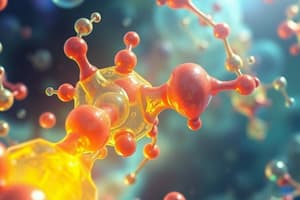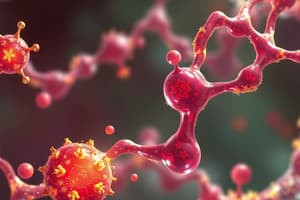Podcast
Questions and Answers
Which class of enzymes is responsible for transferring chemical groups from one molecule to another?
Which class of enzymes is responsible for transferring chemical groups from one molecule to another?
- Transferases (correct)
- Lyases
- Hydrolases
- Ligases
What type of reaction do oxidoreductases catalyze?
What type of reaction do oxidoreductases catalyze?
- Isomerization
- Hydrolysis
- Oxidation and reduction (correct)
- Molecular cleavage
Which enzyme class includes enzymes that can perform nonhydrolytic removal of groups?
Which enzyme class includes enzymes that can perform nonhydrolytic removal of groups?
- Lyases (correct)
- Transferases
- Isomerases
- Hydrolases
According to the Michaelis-Menten Equation, what does 'Vmax' represent?
According to the Michaelis-Menten Equation, what does 'Vmax' represent?
Which of the following statements about enzyme kinetics is true?
Which of the following statements about enzyme kinetics is true?
Which theory suggests that the active site of an enzyme is complementary to the conformation of the substrate?
Which theory suggests that the active site of an enzyme is complementary to the conformation of the substrate?
Which class of enzymes is responsible for cleaving molecules in the presence of water?
Which class of enzymes is responsible for cleaving molecules in the presence of water?
What is the role of 'Km' in the Michaelis-Menten equation?
What is the role of 'Km' in the Michaelis-Menten equation?
What does an increase in Km indicate about the unbound substrate concentration?
What does an increase in Km indicate about the unbound substrate concentration?
Which type of enzyme inhibition does not change Km but decreases Vmax?
Which type of enzyme inhibition does not change Km but decreases Vmax?
What is indicated by a decrease in Km in the context of enzyme kinetics?
What is indicated by a decrease in Km in the context of enzyme kinetics?
Which of the following effects results from the substances found in grapefruit?
Which of the following effects results from the substances found in grapefruit?
In enzyme kinetics, what is Km primarily a measure of?
In enzyme kinetics, what is Km primarily a measure of?
What characterizes uncompetitive inhibition?
What characterizes uncompetitive inhibition?
Which equation is obtained by taking the reciprocal of the Michaelis-Menten equation?
Which equation is obtained by taking the reciprocal of the Michaelis-Menten equation?
What effect does competitive inhibition have on the Km value of an enzyme?
What effect does competitive inhibition have on the Km value of an enzyme?
What is a characteristic of coenzymes that distinguishes them from enzymes?
What is a characteristic of coenzymes that distinguishes them from enzymes?
Which enzyme is associated with NAD+?
Which enzyme is associated with NAD+?
Which coenzyme is utilized in the transfer of one carbon groups?
Which coenzyme is utilized in the transfer of one carbon groups?
Which statement about coenzymes is false?
Which statement about coenzymes is false?
Which of the following coenzymes is specifically known for its role in carboxylation reactions?
Which of the following coenzymes is specifically known for its role in carboxylation reactions?
Which coenzyme is involved in the hydroxylation of aromatic amino acids?
Which coenzyme is involved in the hydroxylation of aromatic amino acids?
What is the primary function of NADP+ in metabolic pathways?
What is the primary function of NADP+ in metabolic pathways?
Which enzyme directly utilizes FAD as a coenzyme?
Which enzyme directly utilizes FAD as a coenzyme?
What is the primary function of enzymes in biological reactions?
What is the primary function of enzymes in biological reactions?
Which component of an enzyme refers specifically to its protein part?
Which component of an enzyme refers specifically to its protein part?
What does it mean for an enzyme to be substrate specific?
What does it mean for an enzyme to be substrate specific?
Which of the following statements about enzyme activity is true?
Which of the following statements about enzyme activity is true?
What is the term used to refer to non-protein molecules that assist enzymes?
What is the term used to refer to non-protein molecules that assist enzymes?
Which of the following represents a characteristic of enzymes that affects their efficiency?
Which of the following represents a characteristic of enzymes that affects their efficiency?
What is a defining feature of a holoenzyme?
What is a defining feature of a holoenzyme?
How is the name of an enzyme generally formulated?
How is the name of an enzyme generally formulated?
Flashcards
Enzyme
Enzyme
A protein that speeds up chemical reactions in living organisms.
Substrate
Substrate
The molecule that an enzyme acts upon.
Enzyme Specificity
Enzyme Specificity
Enzymes only work on specific substrates.
Enzyme Activity
Enzyme Activity
Signup and view all the flashcards
Apoenzyme
Apoenzyme
Signup and view all the flashcards
Cofactor
Cofactor
Signup and view all the flashcards
Simple Enzyme
Simple Enzyme
Signup and view all the flashcards
Holoenzyme
Holoenzyme
Signup and view all the flashcards
Enzyme Class: Oxidoreductases
Enzyme Class: Oxidoreductases
Signup and view all the flashcards
Enzyme Class: Transferases
Enzyme Class: Transferases
Signup and view all the flashcards
Enzyme Class: Hydrolases
Enzyme Class: Hydrolases
Signup and view all the flashcards
Enzyme Class: Lyases
Enzyme Class: Lyases
Signup and view all the flashcards
Enzyme Class: Isomerases
Enzyme Class: Isomerases
Signup and view all the flashcards
Enzyme Class: Ligases
Enzyme Class: Ligases
Signup and view all the flashcards
Induced Fit Theory
Induced Fit Theory
Signup and view all the flashcards
Michaelis-Menten Equation
Michaelis-Menten Equation
Signup and view all the flashcards
Ping-pong mechanism
Ping-pong mechanism
Signup and view all the flashcards
NAD+/NADP+
NAD+/NADP+
Signup and view all the flashcards
FAD/FMN
FAD/FMN
Signup and view all the flashcards
Coenzyme Q
Coenzyme Q
Signup and view all the flashcards
Tetrahydrobiopterin
Tetrahydrobiopterin
Signup and view all the flashcards
Thiamine pyrophosphate (TPP)
Thiamine pyrophosphate (TPP)
Signup and view all the flashcards
What does a higher Km value indicate about substrate binding?
What does a higher Km value indicate about substrate binding?
Signup and view all the flashcards
What is Vmax?
What is Vmax?
Signup and view all the flashcards
What is the relationship between Km and unbound substrate?
What is the relationship between Km and unbound substrate?
Signup and view all the flashcards
What is irreversible inhibition?
What is irreversible inhibition?
Signup and view all the flashcards
How does competitive inhibition affect Km and Vmax?
How does competitive inhibition affect Km and Vmax?
Signup and view all the flashcards
What is the Lineweaver-Burk equation?
What is the Lineweaver-Burk equation?
Signup and view all the flashcards
How does uncompetitive inhibition affect Km and Vmax?
How does uncompetitive inhibition affect Km and Vmax?
Signup and view all the flashcards
What is enzyme induction?
What is enzyme induction?
Signup and view all the flashcards
Study Notes
Enzymes
- Enzymes are protein catalysts that mediate virtually all reactions in the body.
- They catalyze chemical reactions, increasing their rates by a hundred thousand to trillion fold, lowering the energy of activation.
- Enzymes are highly specific, typically interacting with a single substrate or a small set of closely related substrates.
- Enzyme activity is highly sensitive to pH and temperature.
Properties and Characteristics of Enzymes
- Catalyze biological and chemical reactions, speeding them up significantly (millions or billions of times faster).
- Display substrate specificity, meaning each enzyme is designed to interact with only specific substrates.
- Are highly sensitive to pH and temperature changes.
Biomedical Importance of Enzymes
- Involved in numerous biochemical processes including muscle contraction and assembly of building blocks.
- Used in diagnosis (e.g., liver panel tests like ALT, AST, GGT, ALP).
- Essential in pharmacology (e.g., biosynthesis of drugs and antibiotics).
- Utilized in food and industrial processes (e.g., cheese production through rennin, lactose intolerance management through lactase).
- Also used for stain/dirt removal (through proteases and amylases).
Nature of Enzymes
- Most enzymes are proteins in nature.
- Simple enzymes are composed solely of protein molecules.
- Holoenzymes are complex enzymes consisting of protein (apoenzyme) and a non-protein component (cofactor).
- Coenzymes are nonprotein organic molecules that assist enzymes in their function.
- Isozymes are a group of enzymes with similar substrate specificity.
- Metalloenzymes require metal ions for their activity.
Classification and Nomenclature of Enzymes
- Enzymes are often named by adding the suffix "-ase" to the root word of their substrate (e.g., lipase, protease).
- Some have common/trivial names as well (e.g., trypsin, chymotrypsin).
Enzyme Specificity and Efficiency
- Enzymes are specific to their substrates due to the unique 3D shape of the active site.
- The lock-and-key model suggests the active site precisely fits the substrate.
- The induced-fit model proposes that the active site changes conformation to better accommodate the substrate.
Enzyme Kinetics
- Enzyme kinetics explores how reaction rates change with substrate concentration.
- Michaelis-Menten kinetics describe the relationship between substrate concentration and reaction rate.
- The Michaelis-Menten constant (Km) indicates how much substrate is required to achieve half maximum velocity.
Enzyme Inhibition
- Enzyme activity is regulated by inhibitors, which reduce enzyme efficiency.
- Irreversible inhibitors permanently inactivate the enzyme.
- Reversible inhibitors detach from the enzyme after an interaction.
- Types of reversible inhibition include competitive, noncompetitive, and uncompetitive.
Coenzymes
- Coenzymes are non-protein helpers that assist enzymes in their function.
- Most coenzymes are vitamin derivatives.
Multi-Substrate Systems
- Enzyme reactions often involve multiple substrates.
- Sequential reactions follow specific patterns of substrate addition and product release.
- Ping-pong reactions release products at different stages during the reaction sequence.
Lineweaver-Burk Plots
- Graph plotting 1/V against 1/[S] for different substrate concentrations.
- Shows how inhibitors influence enzyme activity.
- Plots are used to calculate Km and Vmax values.
Studying That Suits You
Use AI to generate personalized quizzes and flashcards to suit your learning preferences.




